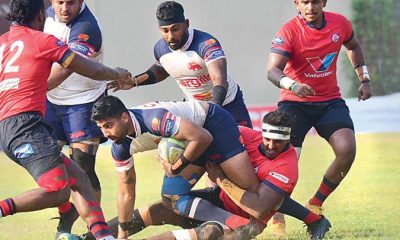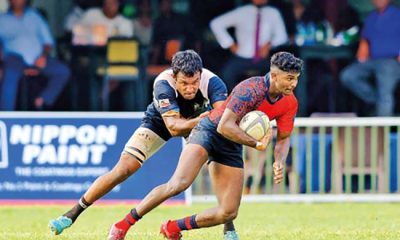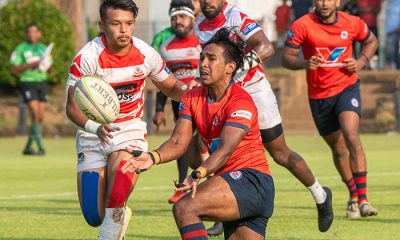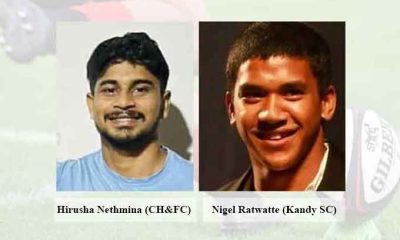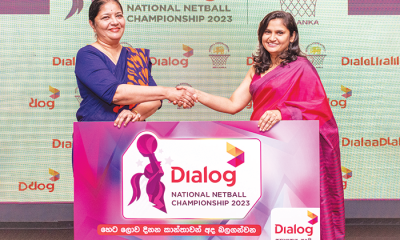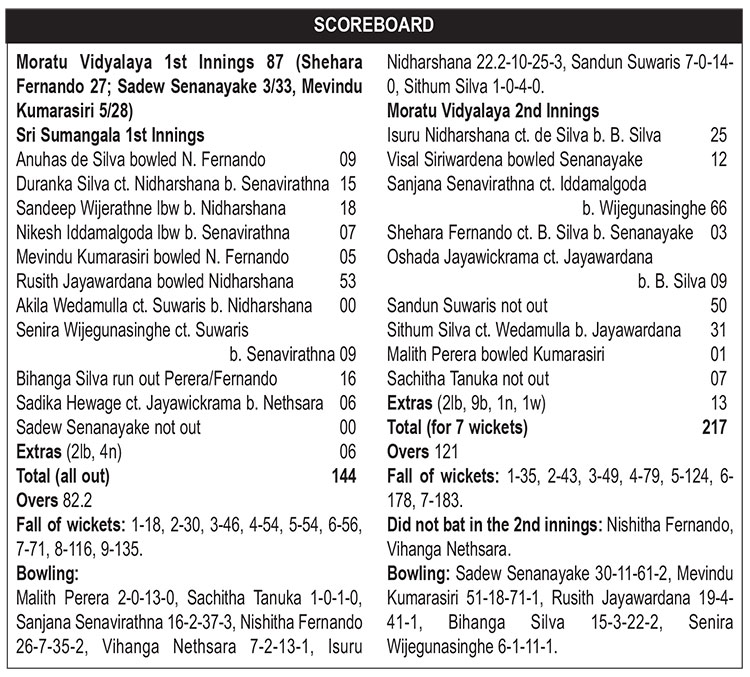Sports
Only if Buultjens knew that teams have pulled out of rugby sevens!

By A Special Sports Correspondent
There is trouble brewing for the Sri Lanka Schools Rugby Football Association (SLSRFA) ahead of the much looked forward to under 19 ‘Elite’ Schools Rugby Sevens because several schools are reported to make themselves unavailable for the two- day competition.
There are several pros and cons to this issue of non-availability of teams. But what should be underscored is that all schools must remember one valuable dictum that even those participating at The Olympics honour; which is ‘participating is more important than winning’. At the time of writing as many as 10 schools have given enough signs that they’ll not be taking part in the competition citing the upcoming O’ Level Exam and also injuries to key players.
One must remember that those who pull out of the competition will be labeled as spoilers. This attitude of pulling out or boycotting a tournament, when at school level, sparks the attitude in individuals to go against a system or be selfish. Are these schools which are struggling to field their best team for the schools rugby sevens giving the message that they don’t have a second-string outfit or junior team in their ranks and are bankrupt for players?
The good news for rugby fans is that the top teams which dazzled at the recently concluded Zahira Centenary Sevens have made themselves available for the tournament which will be worked off at the Royal Sports Complex and CR&FC, according to media reports. St. Peter’s, which won the Cup Championship at the Zahira Sevens, are slotted in with Maliyadeva Kurunegala in group ‘H’ while Isipatana College, which finished as runners-up in that tournament, are pooled in group ‘A’ with St. Benedict’s College. Royal College which won the Plate Championship at the Zahira Sevens are slotted in with Carey and Nalanda in group ‘D’. If some of the popular rugby playing schools opt to pull out then it would leave the doors open for lesser-known rugby playing schools to fill the voids and ensure that the ‘tournament goes on’.
One little error in calculation that is troubling this tournament is the scheduling of the Zahira Sevens too close to the Elite schools rugby sevens. You cannot possibly ask schools to play back-to-back sevens tournaments with just a few days of rest between tournaments. Injuries to players are a key concern for school rugby teams and don’t forget that there is a league tournament – where the stakes are so high- also on the cards and scheduled to commence in June this year. This writer can say so because the Zahira Sevens was conducted with the blessings of the SLSRFA; the rugby authority that draws up the school rugby calendar for the year. The Zahira Sevens was conducted on March 2 and 3 in Colombo with the participation of the best 16 schools teams in the island. There is a school of thought that having two fiercely competitive school rugby sevens tournaments too close to each other is not a good idea and will drain the players of their energies.
Much money and time are invested on school rugby and to prepare the players for traditional and tournament matches. Also, one must remember that the schools 15-a-side season has two tournaments which is followed by trials to select a team for the junior Asian Championship. Schoolboys have to also balance their education with sports. All that must be achieved while in school; before these boys reach the age 21. There are also schoolboys who take part in more than one sport and also dabble in activities outside sports. Some also have dreams of entering university and a handful have to satisfy goals of parents; individuals who want to live their dreams through their children. Hence the pressure on children who do sports and studies can build up to reach breaking point in an individual.
School rugby is so commercialized these days. Just look at the attire of a school rugby player and observe the number of logos of various sponsors stitched to the playing garment. Then there must be the expectations of sponsors too!
This flooding of sponsors to school rugby can throw out existing traditions. No one talks about the Philip Buultjens Trophy which was on offer for the schools rugby sevens winners. Do the school authorities still keep this trophy on display at this tournament and award it to the winners? So many companies engaged in the communication business are involved in rugby and they have their own trophies which they wish to see been given away to winners at the podium. For the record the Philip Buultjens Trophy was first on offer at the schools rugby tournament in 1975 and Trinity led by Rohan Sourjah won that tournament beating Royal 18-16 in the final. Just to talk about endurancein players of those days, the Trinity side was represented by the same seven players during the entire tournament; meaning the reserves were never used. (This information was taken from NeilWijeratne’s well compiled book titled ‘Sevens Saga’).
School rugby at present is thriving thanks to the support of old boys and sponsors. The SLSRFA must be thankful for that. This is because the schools section of Sri Lanka Rugby (SLR) is neither known to have the acumen to handle a complicated sport like rugby nor has it the connections to raise much needed funds for the game.
Many years ago, when the SLSRFA was run by able men like Lal Kumarasinghe (President) and Mohammed Zainudeen (Secretary) the schools tournaments were run with the precision of Swiss watches. Kumarasinghe would handle the tournament desk at schools tournaments by himself. He passed away in 1999. Those were the years of schools rugby and trouble makers were punished then and there with no favors granted because of school or family ties. But still there were politics involved in school rugby even then; especially when the SLR got involved in school rugby on occasions when a national team had to be selected for an overseas tournament.
In the year 1988 SLR received an invitation to compile a school side to contest the Roslyn Park Sevens in England. The team from Sri Lanka comprised Lasitha Guneratne (Captain), Sudesh. Abeysinghe, Asoka Jayasena, Rizwi Suhyb, Bindu Dandeniya, Thakshila Hettiarachchi, M.Thaam, Ruwan Ranasinghe, Hilmy Saheed and Rohan Ranarajah. The selection trials for this tour were conducted in March 1988 and there were disputes regarding who should be coach. After that tour, the inter-school rugby sevens, worked out in August that year, produced an invincible champion side in Kingswood. Sadly, none of the players from the champion Kingswood team got the opportunity to be included in this tour; hence their potential remained untapped from the perspective of being members of the junior national sevens team.
Times have changed and when a tournament uses the name ‘Elite’ sevens one cannot possibly expected a person like Philip Buultjens (A versatile sportsman produced by St. Anthony’s Katugastota) to be remembered in rugby these days. The same can be said about Noel Gratiaen; in whose name the Gratiaen Cup was awarded to the winners of the game between Colombo Schools and Outstation Schools. Gratiaen was a lawyer and also held post of President of SLR in the years 1948 and 1950. People with authority prefer to associate names of mobile phone companies with sports events of today and conveniently forget about our rugby legends.
Coming back to the upcoming Schools Elite sevens the rugby fraternity hopes that most of the team’s that are experiencing the unavailability of players will put their ‘houses’ in order and live up to the spirit of sportsmanship. This April is the time for both the New Year and annual traditional games. A well- conducted rugby event can add to the glamour of the festive season.
Sports
IPL 2025: All-round Delhi Capitals secure second win on the bounce
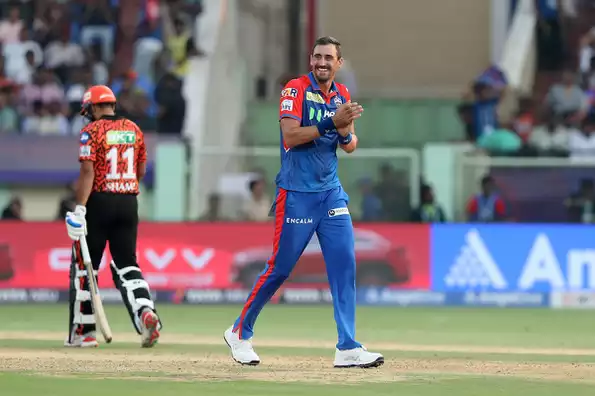
Sunrisers Hyderabad’s philosophy of living by the sword and dying by it led them to their second successive defeat, against Delhi Capitals in Vizag. Mitchell Starc picked his maiden T20 fifer to keep SRH down to 163 despite Aniket Verma’s six-hitting exhibition in a 41-ball 74 before the DC top-order chased it down with 7 wickets and four overs to spare.
Where the match was won?
SRH were hamstrung in the PowerPlay with four dismissals. They got six more than Delhi Capitals did in this phase but it was the repercussions of this phase that led them to an under-par total.
The PowerPlay difference
| Parameters | SRH | DC |
|---|---|---|
| Score | 58/4 | 52/0 |
| Run-rate | 9.67 | 8.67 |
| 4s/6s | 7/1 | 4/3 |
Sunrisers Hyderabad
Powerplay: Starc removes top-order
Phase score: 58/4 [RR: 9.67, 4s/6s: 7/1]
Pat Cummins became the first captain this season to bat first after winning the toss but his high-flying top-order was quickly dismantled by Mitchell Starc. Abhishek Sharma was run out after a mix-up between the openers after which Mitchell Starc took out Ishan Kishan, Nitish Reddy and Travis Head by the fifth over. With that, since IPL 2024, Starc has 8 wickets in 11 overs against SRH in PowerPlay. SRH should’ve been five down before the end of the PowerPlay, but Abishek Porel put down a catch to offer Aniket Verma a reprieve.
Middle-overs: Aniket flies but DC retain control
Phase score: 82/3 [RR: 9.11, 4s/6s: 4/6]
Aniket flexed his muscles against DC’s spinners, starting out by hitting Vipraj Nigam for a six and a four in the seventh over. In the next over, he tonked Axar for two successive sixes and also went after Mohit Sharma. Heinrich Klaasen then welcomed Kuldeep Yadav with a straight six to press on with the fifth-wicket stand. They took the team past 100 by the halfway stage but DC hit back through an excellent catch from Vipraj Nigam that sent the South African back. Kuldeep and Axar then bowled three excellent overs, conceding just eight in it. Aniket meanwhile got to his maiden IPL half-century and went after Axar once again in a 17-run 15th over.
Death overs: Starc bundles out SRH with fifer
Phase score: 23/3 [RR: 6.27 4s/6s: 1/1]
Aniket departed in the 16th over chasing another big six, falling for a 41-ball 74. Starc then came back to quickly wrap the innings up in the 19th over, dismissing Harshal Patel and Wiaan Mulder. While SRH finished on 163, the Aussie quick walked away with figures of 5-35, his first fifer in T20 cricket.
Delhi Capitals
PowerPlay: SRH toil in wicketless phase
Phase score: 52/0 [RR: 8.67, 4s/6s: 4/3]
Faf du Plessis and Jake Fraser-McGurk started well, taking on all four of the bowling options that Cummins threw at them in the PowerPlay. Harshal Patel bowled a good first over but Cummins himself was taken apart for 13 runs. Shami started well but erred in his second to let DC control the game at the start of their chase.
Middle-overs: Zeeshan Ansari strikes thrice but DC march on
Phase score: 98/3 [RR: 10.88, 4s/6s: 9/4]
SRH’s young leggie Zeeshan Ansari picked three wickets but it didn’t alter the course of the proceedings as the hosts galloped along towards the target through different batters. Du Plessis got to a 26-ball half-century while McGurk too showed urgency before falling to the spinner. DC had 96 on the board at the halfway stage, being comfortably ahead of the asking rate. KL Rahul marked his DC debut by smashing Shami for two fours and a six in the 11th over. Abishek Porel then walked out and seamlessly carried on with the run-making, hitting Ansari for a four and a six in the 14th over. DC got to 150/3 in 15 overs, with only 13 more to get at the death.
Death-over: Six balls to wrap it up
Phase score – 16/0 [RR: 16.00, 4s/6s: 2/1]
Porel went after Wiaan Mulder in the 16th over to complete the commanding victory.
Brief Scores:
Sunrisers Hyderabad 163 in 18.4 overs (Aniket Verma 74, Heinrich Klaasen 32, Travis Head 22; Mitchell Starc 5-35, Kuldeep Yadav 3-22, Mohit Sharma 1-25) lost to Delhi Capitals 166/3 in 16 overs (Faf du Plessis 50, Jake Fraser-McGurk 38, Abishek Porel 34*, KL Rahul 15, Tristan Stubbs 21*; Zeeshan Ansari 3-42) by 7 wickets
What next?
Sunrisers head to Kolkata where they face KKR on April 3 while Delhi Capitals have a longer break before taking on CSK in Chennai on April 5.
Latest News
IPL 2025: Rana, Hasaranga give Rajasthan Royals first points with tight win
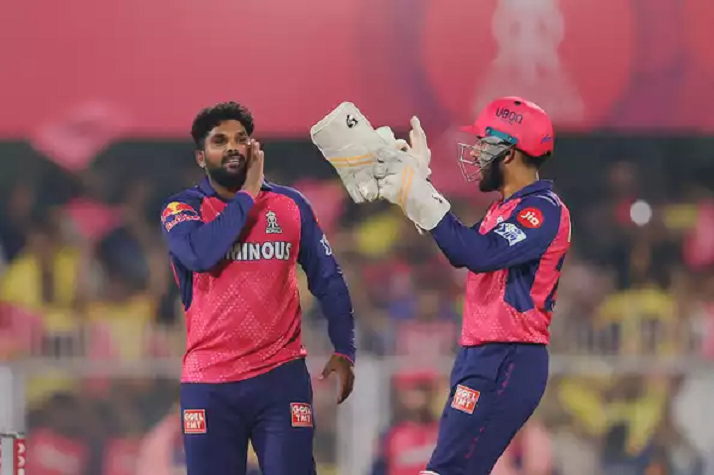
Rajasthan Royals clinched a thrilling six-run victory over Chennai Super Kings to bring up their first win of IPL 2025. Starring with the bat for the Royals was Nitish Rana who hit a powerful 81 before Wanindu Hasaranga helped defend the total with crucial strikes right through .
Where was the match won?
While Rana’s onslaught in the powerplay set RR up to get a total that was above-par, CSK had managed to pull things back at the back-end. In the chase, however, RR managed to keep things in control with regular strikes right through. The chief architect of that was Wanindu Hasaranga who struck at important junctures not allowing CSK to get away.
RAJASTHAN ROYALS
Powerplay – Nitish Rana runs amok
Phase score – 79/1 [RR: 13.16; 4s/6s: 9/5]
Nitish Rana found himself coming in just the first over of the innings after Yashasvi Jaiswal chipped a simple catch to mid off. What had started off well for Khaleel Ahmed and CSK, who had opted to bowl, soon took a turn for the worse. Rana hit the second ball he faced for a boundary to get going. Jamie Overton, making his IPL debut, was carted for 14 runs in his first over and 16 in his next as CSK struggled to get their lengths right. In a bid to shake up things, R Ashwin was brought in but Rana employed the sweep behind square to good effect as RR picked up 19 in that over. Khaleel erred in lengths once again in his third over of the powerplay and allowed Rana to cash in further on a surface that was not offering much for the bowlers. Out of RR’s 79 inside the powerplay, Rana alone accounted for 58.
Middle overs – Spinners pull things back for CSK
Phase score – 66/4 [RR: 7.33; 4s/6s: 4/2]
Rana remained CSK’s biggest threat from one end but Noor Ahmed managed to strike straightaway at the other bagging a well-set Sanju Samson caught at long off. It helped apply the brakes on the scoring-rate although RR had a good base already. Rana though was taking one of CSK’s main weapon in R Ashwin out sweeping him for another four and a six when the offspinner returned. But Ashwin had the last laugh throwing one wide when Rana danced down the track early to be stumped for a 36-ball 81. This helped further CSK’s cause as they applied the squeeze through their spinners. Both Ahmed and Ravindra Jadeja chipped in getting Dhruv Jurel and Wanindu Hasaranga caught off mishits as CSK bounced back successfully.
Death overs – RR stutter at the finish
Phase score – 37/4 [RR: 7.4; 4s/6s: 2/2]
Riyan Parag and Shimron Hetmyer, who was dropped first ball, were the only other batters from RR who found the boundaries apart from the top-order. But neither could get them at the frequency that RR would have liked. Parag was yorked by Pathirana in the 18th over while Hetmyer was caught in the final over. Through it all CSK stitched together overs without boundaries that helped keep them in the game. RR still managed to get past 180 thanks to the initial onslaught from Rana.
CHENNAI SUPER KINGS
Powerplay – Blows exchanged in tight phase
Phase score – 42/1 [RR: 7; 4s/6s: 6/1]
The Guwahati pitch began to assist the pacers more as the game progressed and both Jofra Archer and Tushar Deshpande extracted appreciable bounce from it straihgtaway. The former got one of the balls to kick up and angled across Rachin Ravindra to have him caught behind. Shot-making was not easy through the line in this phase with Ruturaj Gaikwad also being struck on the elbow once. After Archer’s maiden over to start, CSK had put on only 5 on the board after the first three overs. But gradually both Gaikwad and Rahul Tripathi found other ways to get the boundaries. They began to use the pace behind square on the onside and put the bowlers off their lengths. As a result, CSK got some useful boundaries in the latter half of the powerplay which helped get the chase back on track.
Middle overs – Hasaranga keeps CSK in check
Phase score – 80/3 [RR: 8.88; 4s/6s: 6/3]
This was a phase of play that CSK were threatening to break free with wickets in hand. But Rajasthan were almost single-handedly kept in the game by Wanindu Hasaranga’s three strikes through the middle overs. He struck with his first ball having Tripathi caught at deepmidwicket. But CSK had their best spin-hitter in Shivam Dube walk in and he took the attack straight back to Hasaranga hitting him for a six down the ground. He continued the onslaught in Hasaranga’s next over hitting him for a four and a six, readying to get that one big over that could tilt the equation. But Dube fell immediately after thanks to a magical catch at cover by a diving Riyan Parag. But CSK hit back through their skipper Gaikwad who picked up three boundaries off Kumar Kartikeya to keep the run-rate up. When he needed more support at the other end, Vijay Shankar briefly promised to do so hitting Hasaranga for a six but only to be fooled by a googly off the very next ball. Gaikwad brought up his fifty soon after but heading into the final five overs, CSK needed 61 with a set Gaikwad being their biggest bet.
Death overs – CSK fall just short
Phase score – 54/2 [RR: 10.8, 4s/6s: 2/4]
Hasaranga once again played his part in the final overs with Gaikwad trying to take charge. CSK’s captain managed to tonk Hasaranga down the ground for a crucial six but became the legspinner’s fourth victim of the night when he holed out to long on next ball to fall for 63. Hasaranga finished with figures of 4-35 and ensured that he played a major part in RR’s defence of a middling total. For CSK, the onus lied on Ravindra Jadeja and MS Dhoni to make a match out of this in the final stages of the game. RR got back Matheesha Theekshana for the 18th over and the spinner conceding only six with no boundaries, leaving CSK needing 39 off 12. Both the experienced campaigners picked up a six apeice from Tushar Deshpande’s penultimate over and got 19 in all leaving Sandeep Sharma to defend 20 in the final over. Interestingly, RR had turned to him even though jofra Archer [3-1-13-1] had an over left. But to their relief, Sharma saw Dhoni drag a low full toss wide of deepmidwicket where Hetmyer took a sharp running catch under pressure. Sharma saw off the threat from debutant Overton, who lofted him for one six, to eventually take RR home as CSK fell 6 runs short.
Brief Scores:
Rajasthan Royals 182/9 in 20 overs (SanjuSamson 20, Nitish Rana 81, Riyan Parag 37, Shimron Hetmyer 19; Khaleel Ahmed 2-38, Ravichandran Ahwin 1-46, Noor Ahmed 2-28, Matheesha Pathirana 2-28, Ravindra Jadeja 1-10) beat Chennai Super Kings 176/6 in 20 overs (Rahul Tripathy 23, Ruturaj Gaikwad 63, Shivam Dube 18, Ravindra Jadeja 32*, MS Dhoni 16, Jamie Overton 11*; Wanindu Hasaranga 4-35, Jofra Archer 1-13, Sndeep Sharna 1-42) by 6 runs
What next?
Both teams have a five day-gap before their next encounter on April 05 when CSK host the Delhi Capitals while Rajasthan Royals go to Mullanpur to take on the Punjab Kings on the same day.
Sports
Moratu Vidyalaya salvage pride thanks to Sandun’s marathon innings
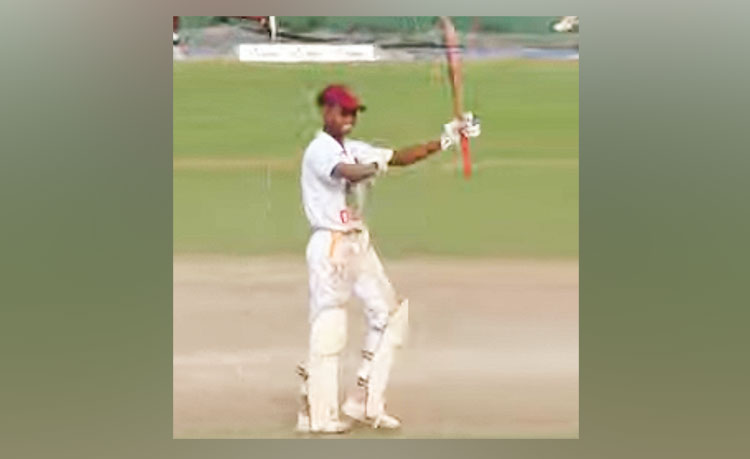
A marathon innings by Sandun Suwaris paved the way for Moratu Vidyalaya to force a draw to the 73rd Battle of the Golds Big Match against Sri Sumangala College Panadura at De Soysa Stadium Moratuwa on Sunday.
Batting for the second time, Moratu Vidyalaya had barely closed the first innings deficit when Suwaris came to bat. They had just six wickets in hand with more than two sessions remaining on the final day when Suwaris rose to the occasion with a fine rearguard action.
The middle order batsman held their batting together with a marathon innings. He faced 258 balls for his unbeaten half century which included just a solitary boundary.
Moratu Vidyalaya fared badly in the first innings as they were bowled out for 87 runs with Mevindu Kumarasiri taking five wickets for 28 runs.
In their essay Sri Sumangala too struggled for runs but a half century by Rusith Jayawardana helped them reach 144 runs.
Earlier Sanjana Senavirathna played a crucial role top scoring with 66 runs. His knock included four fours and two sixes.The Battle of the Golds big match was played as a three day encounter for the first time this year.
-

 Sports2 days ago
Sports2 days agoSri Lanka’s eternal search for the elusive all-rounder
-

 Features6 days ago
Features6 days agoCelebrating 25 Years of Excellence: The Silver Jubilee of SLIIT – PART I
-

 Business6 days ago
Business6 days agoCEB calls for proposals to develop two 50MW wind farm facilities in Mullikulam
-

 Business4 days ago
Business4 days agoAIA Higher Education Scholarships Programme celebrating 30-year journey
-

 News3 days ago
News3 days agoGnanasara Thera urged to reveal masterminds behind Easter Sunday terror attacks
-

 Features6 days ago
Features6 days agoNotes from AKD’s Textbook
-

 News2 days ago
News2 days agoComBank crowned Global Finance Best SME Bank in Sri Lanka for 3rd successive year
-

 Features2 days ago
Features2 days agoSanctions by The Unpunished




